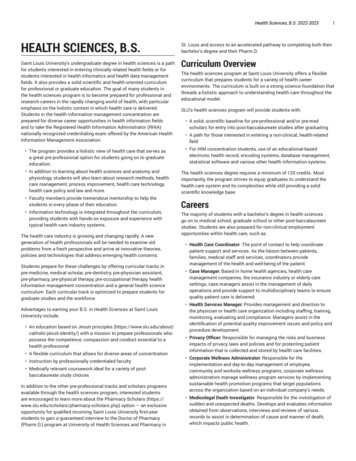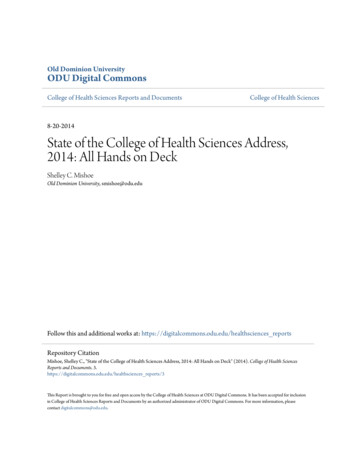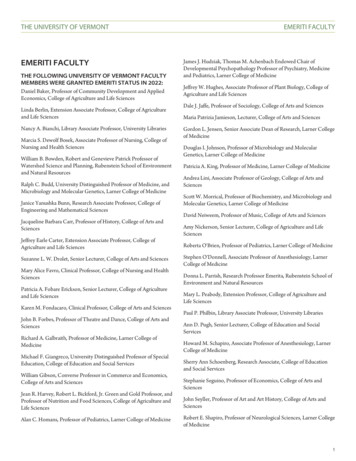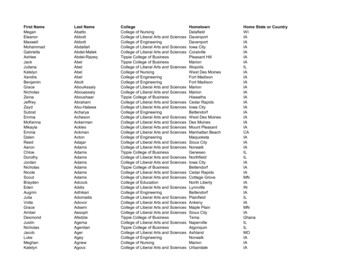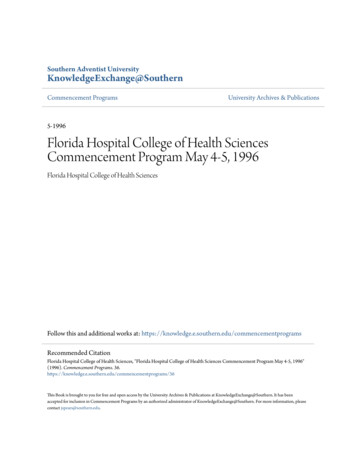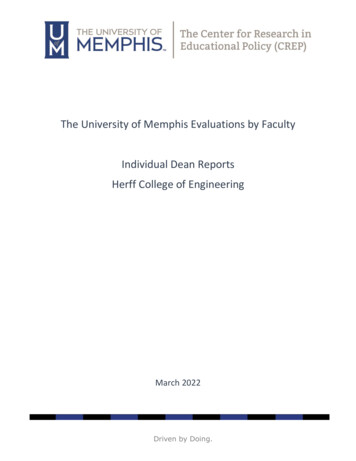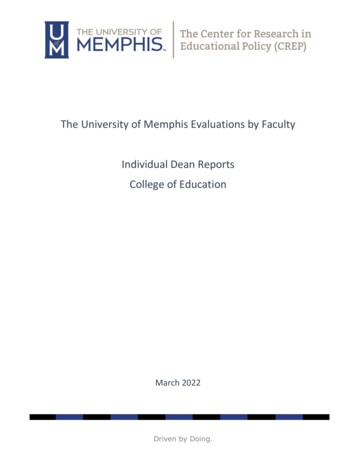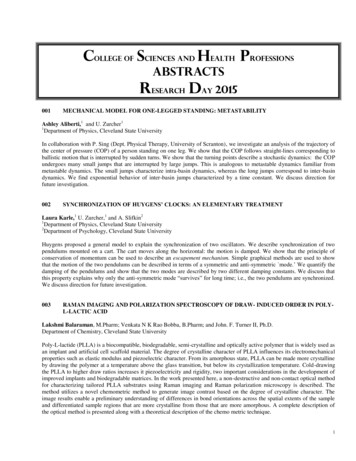
Transcription
COLLEGE OF SCIENCEs and Health ProfessionsAbstractsResearch Day 2015001MECHANICAL MODEL FOR ONE-LEGGED STANDING: METASTABILITYAshley Aliberti,1 and U. Zurcher11Department of Physics, Cleveland State UniversityIn collaboration with P. Sing (Dept. Physical Therapy, University of Scranton), we investigate an analysis of the trajectory ofthe center of pressure (COP) of a person standing on one leg. We show that the COP follows straight-lines corresponding toballistic motion that is interrupted by sudden turns. We show that the turning points describe a stochastic dynamics: the COPundergoes many small jumps that are interrupted by large jumps. This is analogous to metastable dynamics familiar frommetastable dynamics. The small jumps characterize intra-basin dynamics, whereas the long jumps correspond to inter-basindynamics. We find exponential behavior of inter-basin jumps characterized by a time constant. We discuss direction forfuture investigation.002SYNCHRONIZATION OF HUYGENS’ CLOCKS: AN ELEMENTARY TREATMENTLaura Karle,1 U. Zurcher,1 and A. Slifkin21Department of Physics, Cleveland State University2Department of Psychology, Cleveland State UniversityHuygens proposed a general model to explain the synchronization of two oscillators. We describe synchronization of twopendulums mounted on a cart. The cart moves along the horizontal: the motion is damped. We show that the principle ofconservation of momentum can be used to describe an escapement mechanism. Simple graphical methods are used to showthat the motion of the two pendulums can be described in terms of a symmetric and anti-symmetric mode.’ We quantify thedamping of the pendulums and show that the two modes are described by two different damping constants. We discuss thatthis property explains why only the anti-symmetric mode “survives” for long time; i.e., the two pendulums are synchronized.We discuss direction for future investigation.003RAMAN IMAGING AND POLARIZATION SPECTROSCOPY OF DRAW- INDUCED ORDER IN POLYL-LACTIC ACIDLakshmi Balaraman, M.Pharm; Venkata N K Rao Bobba, B.Pharm; and John. F. Turner II, Ph.D.Department of Chemistry, Cleveland State UniversityPoly-L-lactide (PLLA) is a biocompatible, biodegradable, semi-crystalline and optically active polymer that is widely used asan implant and artificial cell scaffold material. The degree of crystalline character of PLLA influences its electromechanicalproperties such as elastic modulus and piezoelectric character. From its amorphous state, PLLA can be made more crystallineby drawing the polymer at a temperature above the glass transition, but below its crystallization temperature. Cold-drawingthe PLLA to higher draw ratios increases it piezoelectricity and rigidity, two important considerations in the development ofimproved implants and biodegradable matrices. In the work presented here, a non-destructive and non-contact optical methodfor characterizing tailored PLLA substrates using Raman imaging and Raman polarization microscopy is described. Themethod utilizes a novel chemometric method to generate image contrast based on the degree of crystalline character. Theimage results enable a preliminary understanding of differences in bond orientations across the spatial extents of the sampleand differentiated sample regions that are more crystalline from those that are more amorphous. A complete description ofthe optical method is presented along with a theoretical description of the chemo metric technique.1
004EXPLORATION OF OCCUPATIONAL THERAPY SERVICES TO PROMOTE OCCUPATIONALPERFORMANCE, PERFORMANCE SATISFACTION, AND QUALITY OF LIFE IN UNIVERSITYFRESHMAN: A PILOT STUDYKaren M. Keptner, Ph.D.; Anthony L. Harris, B.S.; James C. Mellyn, B.S.; Nichole R. Neff, B.S.; Nisanne Rassie, B.B.M.;Karen M. Thompson, B.A.Occupational Therapy Program, School of Health Sciences, Cleveland State UniversityMental health issues contribute to an estimated 64 percent of university dropouts among young adults (National Alliance ofMental Illness, 2012). Interventions implemented by various disciplines may not completely meet the needs of these studentsduring the transition from high school to university roles (O'Keeffe, 2013).This pilot study examined the effectiveness ofOccupational Therapy (OT) services on occupational performance, performance satisfaction, and quality of life (QOL) forfirst time college freshmen. OT services consisted of a weekly group meeting, up to one hour, over the course of five weeks.Topics for the weeks were: leisure, rest and sleep, work, financial budgeting, and social participation. Significant statisticalresults were obtained for the effectiveness of OT services on occupational performance and performance satisfaction, p .05.However, no significant results were obtained when assessing QOL, p .05. Further research is recommended using this OTgroup approach with larger and more diverse groups.005USING PRECHTL’S ASSESSMENT OF GENERAL MOVEMENTS TO DETERMINE LONG-TERMNEUROBEHAVIORAL SEQUELAE IN A NEONATE WITH CONGENITAL PNEUMONIAAUTHORS/INSTITUTIONSMadalynn Tzagournis Wendland, PT, DPT, PCS, ATP, CKTP/CKTFPhysical Therapy Program, School of Health Sciences, Cleveland State UniversityPrechtl’s Assessment of General Movements (GMs) was utilized to determine the integrity of the nervous system andpotential for long-term neurobehavioral sequelae in a neonate diagnosed with congenital pneumonia. Newborns withcongenital pneumonia may present with signs and symptoms including poor feeding and irritability, physiologicalcomplications including respiratory compromise and hypoxemia that can potentially result in central nervous system injury.Prechtl’s Assessment of General Movements is a non-invasive, observational assessment captured through video recordingfor neonates’ 28 weeks gestation through 5 months of age. Previous studies have demonstrated that Prechtl’s Assessment ofGeneral Movements has a higher predictive power compared to traditional, standardized neurological examinations inidentifying neurological deficits with alternative assessments potentially resulting in delayed diagnosis or misdiagnosis ofneurobehavioral impairments.From term to eight weeks, observation of GMs can be utilized to determine the presence of writhing movements. Theclinician categorizes the quality of movements observed as normal, poor repertoire, cramped synchronized or chaotic. Fromnine to twenty weeks post-term, GMs are observed for presence of fidgety movements. The clinician categorizes the qualityof fidgety movements as normal, abnormal or absent. Categorizations that are not normal indicate that that the neonate maybe risk for neurodevelopmental complications.A series of four assessments were completed at 2 and 6, 10 and 14 weeks-post term. Initial concern for long-termneurological sequelae were based on physical examination as well as categorization of cramped-synchronized and poorrepertoire GMs at 2 and 6 weeks-post term, respectively, particularly since cramped synchronized movement patterns areassociated with later diagnosis of cerebral palsy with a specificity of up to 93%. However, the neonate demonstrated fidgetymovements at 10 and 14 weeks post-term. 96% of infants with normal fidgety movements have normal brain function,providing support that the child will have normal neuromotor development.006RUTHENIUM-MODIFIED SENSITIVE NO SENSORS: QUANTIFYING NITRIC OXIDE IN THEPATHOBIOLOGY OF CYSTIC FIBROSISTiyash Bose, Tericka Henderson, Mekki Bayachou, Ph.D.Department of Chemistry, Cleveland State University2
This is a preliminary work towards preparing a device capable to measure nitric oxide levels in a cystic fibrosis cell linemodel. It has been found that exhaled NO levels remain unchanged or reduced in cystic fibrosis patients unlike otherinflammatory lung diseases like asthma where it increases. However, it is not clear whether the lower NO levels in cysticfibrosis correlate with lowered production of this metabolite in the bronchial epithelium. We will present preliminaryresults of our ruthenium oxide modified combined electrodes, and how they can be applied to the study of cystic fibrosis atthe cellular level.In this work, we explore the performance of combined reference/working electrodes modified with ruthenium oxide andPoly(3,4-ethylenedioxythiophene) (PEDOT) in the detection of nitric oxide with the goal to measure nitric oxide at the levelof single or collective cultured cells. The synergistic effect of the electrocatalytic activity of ruthenium oxide and theenhanced surface area for catalytic activity provided by the polymer greatly enhanced the analytical performance of oursensors in terms of sensitivity, selectivity, and stability. With the incorporation of a layer by layer method ofelectrodeposition, we attained a sensitivity of 17 pA/nM towards NO and a detection limit in the vicinity of 500 pM. Inorder to improve the selectivity of our sensors, we coated the surface with nafion and lowered the applied potential. Weattained 86% and 81% decrease in response to nitrite and ascorbic acid respectively after nafion coating.007METALLOPORPHRINS – DECORATED GRAPHENE FOR ENHANCED QUANTIFICATION OFPEROXYNITRITEHaitham Kalil, M.Sc.; Mekki Bayachou, Ph.D.Department of Chemistry, Cleveland State UniversityRecent clinical research indicates that the cytotoxicity role of peroxynitrite (ONOO -) plays an essential role in severalcardiovascular dysfunctions and other diseases triggered by oxidative stress. Peroxynitrite (PON) is a strong oxidizing agentproduced from the diffusion-controlled reaction between nitric oxide radical ( NO) and superoxide anion-radical ( O2-). PONattacks vital components inside the body and initiates deleterious effects via direct and indirect interactions. It reacts directlywith lipids, DNA, and proteins and indirectly serves as a trigger of radical chain reactions.Previously, we have shown that hemin and hemin-modified graphene can be used as catalytic platforms for electrochemicaldetection and quantification of peroxynitrite. In this work we prepare metal-decorated graphene-based composite materials aspotential catalytic interfaces for sensitive electrochemical determination of PON. We first describe the method of preparationof metal-modified graphene materials. We characterize the hybrid materials using a number of methods including scanningelectron microscopy (SEM), atomic force microscopy (AFM), raman, and x-ray photoelectron spectroscopy (XPS). Themodified metal-graphene composite is then tested on carbon electrodes for PON detection and quantification usingvoltammetry and dose-response amperometry. We compare and contrast the performance of the new metal-graphenematerials with hemin-only based electrodes as well as bare graphene based electrodes.008STUDYING REVERSIBLE VOLUME PHASE TRANSITION OF POLYSACCARIDE MICROGELSJanna Mino, Krista Freeman, B.S.; Kiril A. Streletzky, Ph.D.Department of Physics, Cleveland State UniversityTemperature sensitive polysaccharide microgels and parent amphiphilic polymer solution were studied in parallel withDynamic (DLS) and Static Light Scattering (SLS) spectroscopies. The microgels showed a reversible volume phase transitionwhich was accompanied by a significant change in microgel volume/composition and depended on the rate of temperaturechange. Coupling DLS and SLS techniques on microgels and polymer solutions allowed to deduce microgel size, structure,molecular weight and a relative change in microgel water content during the volume phase transition. It also allowedcomparing controlled dewetting transition in microgels with corresponding phase transition in parent polymer solution.Flory-Huggins Mean Field Theory was used to model the volume phase transition in microgels.3
009OLDER ADULT SEXUALITY: A CLINICAL PERSPECTIVEErin Blake, BS, BA; Christina Morales Dvorak, BS; Erin Vandrak, BS; Robert Hundt, BS; Tausha Bowers, BS;Robin Chilton, OTR/L, MBAMaster of Occupational Therapy Program, School of Health Sciences, Cleveland State UniversityAs the population of the United States advances in age, knowledge about sexuality in middle to late life is becomingincreasingly important. Education at the collegiate level has the potential to provide future healthcare professionals thefoundation to become informed on the issues regarding sexuality and aging, in order to comfortably and openly address thesubject matter to future clients. A comprehensive needs assessment directed five Master of Occupational Therapy Students atCleveland State University (CSU) to create a 16-week online elective course entitled “Older Adult Sexuality: A ClinicalPerspective”. The course is designed to serve the needs of both undergraduate and graduate students, and has the potential tobecome an elective course for the CSU Certificate for Gerontological Studies. Informative weekly PowerPoints supplementthe required readings, formative assessment discussion posts, and educational videos. Course topics include: cross-culturaland media perspectives, knowledge and attitudes toward sexuality and aging, sexuality in long-term care, coping with chronicillness and disability, sexually transmitted diseases, specific female and male issues, lesbian-gay-bisexual-transgender(LGBT) concerns, emergent issues, and adaptive strategies. Students electing to take this course will have the opportunity toapply their knowledge learned in the community by completing a structured older adult interview as a form of summativeassessment. All graduate students will complete a research paper in addition to the other assignments. Finally, the midtermand final examination will serve as a course evaluator to determine how well the information was presented and the studentslearned.010EVALUATING THE PRO-MUTAGENIC REPLICATION OF 8-OXOGUANINEAnvesh Dasari1, Dr. Anthony J Berdis1, 2, 3 *1Department of Chemistry, Cleveland State University2Center for Gene Regulation in Health and Disease, Cleveland State University3Red5 Pharmaceuticals, LLCOxidative stress produces reactive oxygen species that can damage DNA. The consequences of this can be devastating as theformed DNA lesions are mutagenic and their misreplication cause diseases such as Parkinson’s disease and cancer. 8oxoguanine (8-OG) is one such lesion that could initiate mutagenesis due to its miscoding nature. Oxidation to the C-8position of guanine changes its equilibrium from the normal anti conformation to the syn conformation. This simpleconformational change results in the misinsertion of dATP opposite the lesion rather than dCTP. To better understand themutagenic replication of 8-OG, we performed a thorough kinetic analyses for the incorporation of natural and modifiednucleotide analogs opposite this miscoding DNA lesion using a high-fidelity DNA polymerase. Mechanistic studies Usingmodified purines as substrates, our mechanistic work demonstrate that alterations to functional groups associated withhydrogen bonding interactions cause significant decreases in the overall efficiency for their utilization. Surprisingly, thelower efficiencies result from large reductions in the rate constant for insertion rather than from negative effects onnucleotide binding. In fact, all modified nucleotides tested here display higher binding affinities against 8-OG compared tonatural nucleotide substrates (dCTP and dATP). These results suggest that substrate binding is influenced by the hydrophobicnature of the incoming nucleotide while the chemistry step is controlled by the formation of correct hydrogen-bondinginteractions between the incoming nucleotide and templating nucleobase. Collectively, these studies help explain the promutagenic nature of 8-OG. Future studies are aimed at designing additional nucleotides that can monitor the cellularreplication of 8-OG as well to develop inhibitors to block its misreplication.011THE EFFECTS OF PSYCHOTROPIC MEDICATIONS ON DYSPHAGIA IN OLDER ADULTSAlicia F. Holod, B.A., Monica Gordon Pershey, Ed.D., CCC-SLPSpeech and Hearing Program, School of Health Sciences, Cleveland State UniversityThis literature review, completed to fulfill the requirements for an undergraduate Honors project, examined how the use ofpsychotropic pharmacotherapy in adults aged 65 and older may be related to the presence of active dysphagia (i.e., difficultyswallowing) in medicated patients. The purpose of the study was to determine whether the current medical research indicates4
that use of psychotropic medications prescribed to alleviate anxiety, depression, and psychosis may induce or exacerbateswallowing difficulty in a population already predisposed to dysphagia due to aging and/or other disorders common. Thisreview characterized three classes of psychotropic medications (antianxiety, antidepressant, and antipsychotic) that maycause or exacerbate dysphagia and explored the drugs’ types, actions, main effects, and interaction effects. Findings of thisreview confirm that psychotropic medications may induce or exacerbate dysphagia as a complication of the drug’s intendedeffect or as a side effect. This study is relevant for the field of speech-language pathology in that speech-languagepathologists (SLPs) are the primary service provider on the medical team that treats dysphagia. However, the speechlanguage pathology literature provides very little discussion of the effects of psychotropic medication on dysphagia. Thisreview brings information from the medical literature to light for SLPs. Implications for SLPs’ practical diagnosis andtreatment of dysphagia in patients who have been prescribed psychotropic medications are presented. The authorsacknowledge the Louis Stokes Cleveland Veterans Administration Medical Center for providing the CSU Honors studentwith the opportunity to shadow an SLP, CSU alumna Sarah Miller, during the summer of 2014 and thereby observe thediagnosis and treatment of dysphagia in patients who have been prescribed psychotropic medications.012“IF I CAN EASE ONE LIFE THE ACHING”: A CULTURAL APPROACH TO VOLUNTEERING INHOSPICE CAREMegan C. Smith, B.A., Monica Gordon Pershey, Ed.D., CCC-SLPSpeech and Hearing Program, School of Health Sciences, Cleveland State UniversityThe definition of culture includes many considerations beyond perceptions of race, ethnicity, or socioeconomic status.Culture can simply be defined as a series of experiences shared by members of a community. In this sense, caregivers,patients, and families involved in the hospice care community certainly share a culture, which is varied and vibrant. Thisculture, though infrequently discussed, incorporates aspects of celebration, reflection, and legacy. As a three-year volunteerwith the Hospice of the Western Reserve, headquartered in Cleveland, Ohio, the first author has drawn from her experiencesto create a guidebook for prospective volunteers. Hospice care facilities rely heavily on volunteers to provide effectiveservice, and, most importantly, to maintain a peaceful environment for hospice patients during their final hours. Volunteersneed to meet hospice expectations for interacting with patients, families, health care staff, and other volunteers. Theguidebook, adapted herein to a poster presentation format, focuses on a culturally sensitive approach to hospice care andtakes into account varied racial, ethnic, linguistic, and religious considerations, along with the aforementioned unique cultureof hospice care. The guidebook explores how volunteers can learn about different cultures’ beliefs about death and offerssuggestions for how volunteers can cope with their own emotional taxation. The first author, who completed this guide tofulfill the requirements for an undergraduate Honors project, will enter medical school in the fall of 2015. This guidebookand poster serve as learning tools for any prospective health care professionals who may enter a hospice care setting.013SPEECH SOUND PRODUCTION DEFICITS IN CHILDREN WITH VISUAL IMPAIRMENT: APRELIMINARY INVESTIGATION OF THE NATURE AND PREVALENCE OF CO-OCCURRINGCONDITIONSKyle L. Brouwer, Ph.D., CCC-SLP1, Monica Gordon Pershey, Ed.D., CCC-SLP21Department of Communication Sciences and Disorders, University of South Dakota2Speech and Hearing Program, School of Health Sciences, Cleveland State UniversityChildren’s speech sound production is dependent upon cognitive-linguistic and perceptual processes. In contrast to the wellresearched effects of auditory impairment on children’s speech sound production, there is considerably less information onspeech sound production deficits in children with vision impairment (VI). Some past research indicates that insufficientvisual input contributes to children’s risk for speech sound production deficits. In the U.S., 0.6% of youth under age 18 haveVI (blindness in one or both eyes or vision uncorrectable by glasses). This represents 448,000 youth. One in every 20preschoolers has VI. The present study explored the frequency of occurrence of speech sound production deficits in schoolage children with VI. A survey of VI professionals provided estimates of the percentage of their students with VI who havecoexisting speech sound production deficits. The rationale for using a survey methodology was that VI professionals have aunique vantage point for identifying what is known about the development of children with VI. This survey is an indirectmeasure that can yield some initial evidence and begin the groundwork for more detailed direct investigations of speechsound production in children with VI. Survey questions probed the characteristics of the students, including the severity of5
VI, age of onset of VI, cognitive abilities, and the severity of speech sound production deficits that necessitate speechlanguage therapy. Statistical analyses of the responses show that the percentage of students with VI who receive speechsound production interventions (71%) was higher than expected when compared to the typical percentage of school age youthwho receive speech-language interventions (estimated by the NIDCD at 8-9%). There is a need for future study of thecoexistence of VI and speech sound production deficits.014EXCESSIVE REASSURANCE SEEKING PREDICTS DEPRESSION VIA STRESS GENERATIONKelsey J. Pritchard, B.A., Krysten Osinski, B.A., Ilya Yaroslavsky, Ph.D.Department of Psychology, Cleveland State UniversitySeeking reassurance excessively unintentionally generates negative life events and causes rejection by social supports whobecome frustrated from being asked to excessively provide reassurance. Though prior research tentatively supports stressgeneration and reduced social support as mechanisms for depressogenic effects of excessive reassurance seeking (ERS), moststudies examine these mechanisms independently of one-another. Further, they do not consider that reduced social supportmay exacerbate interpersonal stress. To overcome this, our study tests two models wherein: 1) ERS predicts stress generationand social support erosion as independent contributors to depression risk (Model 1) and 2) social support erosion exacerbatesthe adverse effects of stress generation from ERS behavior (Model 2). Participants (n 364) completed measures of ERS(DIRI), depression (BDI-II), social support (SSQ), and interpersonal negative life events (NLEQ) in a single session (T1). Asubsample of these subjects (n 104) were administered the same questionnaires 4 weeks later (T2). Change in mediators anddepression were calculated via differences scores between T1 and T2 variables (ΔNLEQ, ΔSSQ, ΔBDI). Model 1 waspartially supported: ERS significantly predicted increased interpersonal stress, both concurrently and over time, which thenpredicted concurrent depression symptoms and their maintenance. Contrary to expectation, while social support predictedlower depressive symptoms, ERS predicted social support only at trend levels, and was unrelated to social support over time.Model 2 was tentatively supported: high levels of social support attenuated the effects of interpersonal stress on depression attrend levels, but not over time. These findings suggest that ERS effects on depression risk are partially explained byincreased interpersonal stress. Tentative support was found for social support erosion by ERS to aggravate depressogeniceffects of interpersonal stress. Results suggest that ERS predicts a cascade of processes that increase the depression risk.Therefore, ERS may be a viable target of depression prevention efforts.015SELF-ASSOCIATION OF LIPID-FREE APOLIPOPROTEIN A-I AND THE FORMATION OF HIGHDENSITY LIPOPROTEINCelalettin Topbas, B.S.1,2, Joseph A. Didonato, Ph.D.2,3, Jonathan D. Smith, Ph.D.2, Stanley L. Hazen, M.D., Ph.D.2,3,4,Valentin Gogonea, Ph.D.1,2,3*1Department of Chemistry, Cleveland State University2Department of Cellular and Molecular Medicine, Cleveland Clinic3Center for Cardiovascular Diagnostics and Prevention, Cleveland Clinic4Department of Cardiovascular Medicine, Cleveland ClinicApolipoprotein A-I (apoA-I), the main protein constituent of high density lipoprotein (HDL), forms a dimeric antiparallelstructure that both confers nascent HDL stability and provides a scaffold for the lipid phase. We performed kinetic analysesof monomeric and oligomeric apoA-I employing both hydrogen-deuterium exchange mass spectrometry (HDX-MS) andfunctional lipidation assays. At low concentrations lipid-free apoA-I is monomeric based on equilibrium PAGE, dynamiclight scattering, and cross-linking studies. Despite this, the protein displays in multiple discrete yet reproducible regionsbimodal HDX kinetics indicating the presence of intra-molecular protein – protein interactions (hairpin loops). Kinetic HDXstudies further reveal that at higher concentrations, lipid-free apoA-I self-associates and dimerizes through a ten amino acidC-terminus domain (E223-A232). This is suggested by the appearance of new intermolecular interactions surfacing at higherapoA-I concentrations concurrent with the multimeric apoA-I forms. Surprisingly, apoA-I self-association through E223-A232,an equilibrium process, significantly slowed down the rate of apoA-I lipidation. Our studies indicate that HDL genesis startswith lipidation of apoA-I monomers followed by apoA-I dimerization in an antiparallel fashion on the lipid surface.6
016CARBAMYLATED HIGH DENSITY LIPOPROTEIN IS ATHEROGENIC AND PRO-IMFLAMMATORYSokhna Seck1,2; Camelia Baleanu Gogonea, Ph.D.2; Celalettin Topbas, B.S.1,2; Joseph A. DiDonato, Ph.D.2,3; Stanley L.Hazen M.D., Ph.D.2,3,4; Valentin Gogonea, Ph.D.1,2,3*1Department of Chemistry, Cleveland State University2Department of Cellular and Molecular Medicine, Cleveland Clinic3Center for Cardiovascular Diagnostics and Prevention, Cleveland Clinic4Cardiovascular Medicine, Cleveland ClinicHigh density lipoprotein (HDL-“good cholesterol”), the main carrier of excess cholesterol from periphery tissue to liver, hasbeen found prone to oxidative modification. Recent studies demonstrated that highly oxidized forms of HDL, either as poorlipidated or mature particle are atherogenic and pro-inflammatory. Protein carbamylation, a major posttranslationalmodification of HDL, has been demonstrated to predict an increased cardiovascular risk. The aim of this research project is toidentify oxidatively damaged domains of HDL responsible for NF-kB activation, a transcription factor that regulates cellularactivity in stress/injury. To localize the carbamylated lysines that trigger NF-kB activation, apolipoprotein A1 (the majorprotein component of HDL) deletion mutants were expressed, and will be analyzed by VCAM assay. Earlier research showedthat plasma enzyme myeloperoxidase (MPO) binds to HDL in plasma, and our preliminary results demonstrate that poorlipidated apoA1 and reconstituted nascent HDL (nHDL) modified by the MPO/H2O2/SCN- system (H2O2: hydrogen peroxide,SCN-: thiocyanate ion) are pro-inflammatory. The long term goal of this project is to understand, at the molecular level, themechanistic link between HDL carbamylation and the pro-inflammatory response it generates by activating the NF-kBtranscription factor involved in regulating pathways of the immune response.017PROTECTIVE EFFECTS OF SELF-HANDICAPPING FOR ANXIOUS INDIVIDUALSJessica S. Durey, B.A.; Brooke K. Strumbel, B.A.; and Ilya Yaroslavsky, Ph.D.Department of Psychology, Cleveland State UniversitySelf-handicapping is an avoidance-based response attempting to attribute one’s potential failure to an external source. Thisresponse has short-term protective effects, as it has been linked to transient reductions in cognitive risk factors for depressionand enhanced self-esteem when facing failure (Rhodwalt & Hill, 1995). The aims of this study are to 1) examine whetherself-handicapping has protective effects during an evaluative task, and 2) explore whether these benefits would be higher foranxious individuals. Data was collected from 158 subjects (86.5% female, MAge 23.63, SD 6.01) who completed anexperimental protocol under high evaluation threat. Subjects completed measures of anxiety (Beck Anxiety Inventory), statenegative and positive affect (NA & PA) (Positive and Negative Affect Scale), and claimed handicaps, prior to participating inan evaluative task with pre-determined success (96th %ile) and failure (20th %ile) feedback. Subjects then completed theaffect measure to determine change in NA and PA as a function of feedback. Results showed PA reduction in the failurerelative to success conditions (β .14, p .05), but no change in NA ratings, suggesting feedback manipulation wassuccessful. Results failed to support our first hypothesis. Self-handicapping did not predict change in either affects alone, orin the context of the failure feedback conditions. Results from a linear regression supported the second hypothesis: relative totheir low anxiety peers, subjects with high anxiety retained their PA across the experimental protocol, irrespective offeedback condition (β
1 C OLLEGE OF S CIENCEs and H ealth P rofessions Abstracts R esearch D ay 2015 001 MECHANICAL MODEL FOR ONE-LEGGED STANDING: METASTABILITY Ashley Aliberti,1 and U. Zurcher1 1Department of Physics, Cleveland State University In collaboration with P. Sing (Dept. Physical Therapy, University of Scranton), we investigate an analysis of the trajectory of

